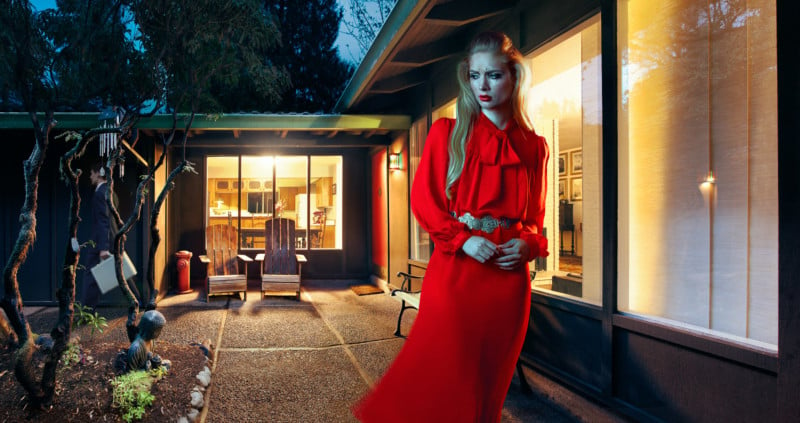Elaborate Photos Created in Small Spaces and with Tight Budgets
![]()
Kate Woodman has mastered taking exceptionally creative images in small, mundane spaces and teaches others how to do the same. What started out as a necessity has now become an art form.
From an Engineer to a Conceptual Artist
Woodman found her love for photography while living and working as an engineer in New Zealand. Landscape and travel photography was her first interest, but soon after moving back to the United States, she turned to photographing people.
“These days my style has evolved into a blend of both environment and people and I love to shoot people on location — and particularly, in interior spaces,” Woodman tells PetaPixel.
Photographing indoors in what Woodman refers to as “basic” spaces was integral to building her now successful photography career. She didn’t have access to funds to afford luxury rental spaces. And while she had always loved historic architecture and interiors, she did not want to commit money or time to renting locations until she knew how to make the most of them with her photography skills.
“So I started practicing shooting in my own home to teach myself how to light interiors, how to place subjects, and how to create stories, so that I could eventually apply those techniques to higher production value shoots,” she explains.

“Through this process, I discovered that there’s actually lots of beauty to be found in more mundane spaces, and that when you have limited resources, it really forces you to focus on creating a really good concept or story. It also teaches you about really stretching the resources that you have to make the most of them, which is a really valuable skillset for a photographer.”
A major lesson learned from shooting in limited spaces is creative problem-solving. Without the big space, the ideal set design, or color palette, photographers learn to adapt, Woodman says.
![]()
These limitations prompt photographers to look for different angles they haven’t considered before or encourage them to learn new lighting or editing techniques that can make all the difference. The same goes for applying color theory — something Woodman is an expert in.
“I think when you are given a set of limited parameters, you always try to push them to the limit, whereas when you have unlimited resources, it can almost be paralyzing because you have too many options,” she says.
Creating a Narrative With Limited Resources
When faced with a small space, where should photographers begin to turn it into something extraordinary? For Woodman, the inspiration comes from the space itself. She takes what she sees in front of her and builds a story step by step.
“I think it’s really important to think about the symbiosis between a subject and their environment, she explains. “You’re not going to shoot a 60s Mod fashion story in a 1980s interior because they don’t correlate, but you can take references from the existing design of a space and build your idea around that.”
![]()

![]()
“My last house was built in 1964, so a lot of the stories I created were more mid-century or vintage inspired because it worked with the architecture I had,” Woodman adds. “But I could easily have played with juxtaposition and put a character in 1860s clothes interacting with the space in a more modern way to put a conceptual twist on things, which is something I like to do a lot in my work.”
To create something different means adding unexpected elements to not only surprise the audience but also invite it to engage and complete the story are seeing. It’s also a clever method to move the attention away from the “mediocrity of a space.”

These and other tips are what Woodman also teaches in her online tutorials, like the “Making The Most Of Your Space: High Production Value Photography On A Budget” course. Having taught courses and workshops on color theory and fashion photography at the Academy of Art University, Woodman’s online course touches on all different aspects to help photographers create something special with limited resources.
“I really strived to put as much practical and detailed info in this tutorial that I think could be of benefit to photographers at all levels, from beginner to advanced,” she says. “This tutorial really takes a deep dive into the not just the how of saving money and working resourcefully, but also the why of the approach that I take and how to do it successfully.”
More of Woodman’s work can be found on her website and Instagram, with her photography tutorial available on Class101.
Image credits: Photos by Kate Woodman. Header photo titled, “Snow White.”